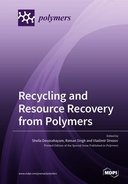Explore

Recycling and Resource Recovery from Polymers
0 Ungluers have
Faved this Work
Login to Fave
Environmental challenges posed by wrong end of lifeplastic management drive the plastics recycling schemes for energy recovery and cutting emissions, penalties, energy consumption, non-renewable resources, and manufacturing costs. Plastic recycling has the lowest environmental impact on global warming potential and total energy use. However, under-utilised plastic wastes due to low value issues with sorting/contamination pose major challenges. Novel technologies drive innovation in a circular economy model for plastics and employ reuse, recycling and responsible manufacture solutions, support the development of new industries and jobs, reduce emissions and increase efficient use of natural resources (including energy, water and materials). Many economies are working towards achieving a zero plastic waste economy. This Special Issue covers the applications of recycled plastics in the areas of energy recovery/alternative fuels, economic analyses, bitumen additives, flame retardants, recycled polymer nanocomposites to enhance the mechanical property, thermomechanical recycling to improve physical properties, mechano-chemical treatment, cryogenic waste tyre recycling, application in decarbonizing technology, e.g., cement industry, waste characterization, improving agricultural soil quality, as smart fertilizers. The Editors express their appreciation to all the contributors across the world in the development of this reprint. This reprint gives different perspectives and technical ideas for the transformation of plastic wastes into value-added products and to achieve higher recycling rates in the coming years.
This book is included in DOAB.
Why read this book? Have your say.
You must be logged in to comment.
Rights Information
Are you the author or publisher of this work? If so, you can claim it as yours by registering as an Unglue.it rights holder.Downloads
This work has been downloaded 97 times via unglue.it ebook links.
- 97 - pdf (CC BY) at Unglue.it.
Keywords
- activation energy
- Alternative fuels
- animal manure
- automotive shredder residue
- ball milling
- bituminous modifier
- carbon conversions
- carbon nanotubes
- cement decarbonization
- chain extension
- chemical analysis
- circo-economics
- Circular Economy
- clean energy
- co-pyro-gasification
- co-pyrolysis
- combustion
- compatibilisation
- Composition
- Contamination
- creep compliance
- cryoagent
- dispersion
- dynamic modulus
- Economics
- Economics, finance, business & management
- Environmental economics
- Environmental science, engineering & technology
- epoxy resin
- flame retardancy
- functionalization
- Hamburg wheel-tracking
- impact properties
- indirect tensile strength
- kinetics
- lignin
- lignin modified bitumen
- linear correlation
- linear viscoelastic properties
- liquid nitrogen
- long-chain branching
- material circularity indicator
- Mechanical properties
- mechanical recycling
- mechano-chemical treatment
- n/a
- non-isothermal crystallisation kinetics
- non-soot catalysts
- open graded friction course
- packaging
- plastic waste
- pollution control
- poly (3-hydroxybutyrate-co-3-hydroxyvalerate)
- poly (l-lactic acid)
- polyethylene
- polyethylene-modified bitumen
- polymer
- polymer based post-consumer waste
- polymer-modified asphalt
- polypropylene
- polysilicone
- post-consumer waste
- reactive extrusion
- recycled opaque PET
- recycling
- Reference, information & interdisciplinary subjects
- relaxation modulus
- Research & information: general
- rheological behavior
- road engineering
- Rubber
- rutting
- silicone
- solid recovered fuel
- Sustainable Energy
- synergy
- Technology, engineering, agriculture
- tensile properties
- thermal conductivity
- thermal degradation
- thiol-ene
- viscoelastic properties
- waste tire
- waste utilization
- waste-to-energy
- wax-based additives
Links
DOI: 10.3390/books978-3-0365-4537-0Editions

